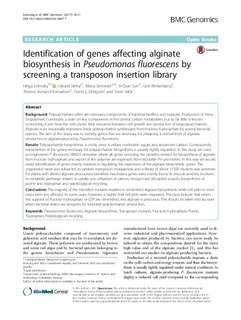| dc.contributor.author | Ertesvåg, Helga | |
| dc.contributor.author | Sletta, Håvard | |
| dc.contributor.author | Senneset, Mona | |
| dc.contributor.author | Sun, Yi-Qian | |
| dc.contributor.author | Klinkenberg, Geir | |
| dc.contributor.author | Konradsen, Therese Aursand | |
| dc.contributor.author | Ellingsen, Trond E | |
| dc.contributor.author | Valla, Svein | |
| dc.date.accessioned | 2017-03-13T13:04:25Z | |
| dc.date.available | 2017-03-13T13:04:25Z | |
| dc.date.created | 2017-01-07T11:34:22Z | |
| dc.date.issued | 2017 | |
| dc.identifier.citation | BMC Genomics. 2017, 18 (1), . | nb_NO |
| dc.identifier.issn | 1471-2164 | |
| dc.identifier.uri | http://hdl.handle.net/11250/2433973 | |
| dc.description.abstract | BACKGROUND: Polysaccharides often are necessary components of bacterial biofilms and capsules. Production of these biopolymers constitutes a drain on key components in the central carbon metabolism, but so far little is known concerning if and how the cells divide their resources between cell growth and production of exopolysaccharides. Alginate is an industrially important linear polysaccharide synthesized from fructose 6-phosphate by several bacterial species. The aim of this study was to identify genes that are necessary for obtaining a normal level of alginate production in alginate-producing Pseudomonas fluorescens. RESULTS: Polysaccharide biosynthesis is costly, since it utilizes nucleotide sugars and sequesters carbon. Consequently, transcription of the genes necessary for polysaccharide biosynthesis is usually tightly regulated. In this study we used an engineered P. fluorescens SBW25 derivative where all genes encoding the proteins needed for biosynthesis of alginate from fructose 6-phosphate and export of the polymer are expressed from inducible Pm promoters. In this way we would avoid identification of genes merely involved in regulating the expression of the alginate biosynthetic genes. The engineered strain was subjected to random transposon mutagenesis and a library of about 11500 mutants was screened for strains with altered alginate production. Identified inactivated genes were mainly found to encode proteins involved in metabolic pathways related to uptake and utilization of carbon, nitrogen and phosphor sources, biosynthesis of purine and tryptophan and peptidoglycan recycling. CONCLUSIONS: The majority of the identified mutants resulted in diminished alginate biosynthesis while cell yield in most cases were less affected. In some cases, however, a higher final cell yield were measured. The data indicate that when the supplies of fructose 6-phosphate or GTP are diminished, less alginate is produced. This should be taken into account when bacterial strains are designed for industrial polysaccharide production. | nb_NO |
| dc.language.iso | eng | nb_NO |
| dc.publisher | BioMed Central | nb_NO |
| dc.relation.uri | http://www.biomedcentral.com/1471-2164/18/11 | |
| dc.rights | Navngivelse 4.0 Internasjonal | * |
| dc.rights.uri | http://creativecommons.org/licenses/by/4.0/deed.no | * |
| dc.title | Identification of genes affecting alginate biosynthesis in Pseudomonas fluorescens by screening a transposon insertion library. | nb_NO |
| dc.type | Journal article | nb_NO |
| dc.type | Peer reviewed | nb_NO |
| dc.source.pagenumber | 13 | nb_NO |
| dc.source.volume | 18 | nb_NO |
| dc.source.journal | BMC Genomics | nb_NO |
| dc.source.issue | 1 | nb_NO |
| dc.identifier.doi | 10.1186/s12864-016-3467-7 | |
| dc.identifier.cristin | 1422769 | |
| dc.description.localcode | © The Author(s). 2017Open AccessThis article is distributed under the terms of the Creative Commons Attribution 4.0International License (http://creativecommons.org/licenses/by/4.0/), which permits unrestricted use, distribution, andreproduction in any medium, provided you give appropriate credit to the original author(s) and the source, provide a link tothe Creative Commons license, and indicate if changes were made. The Creative Commons Public Domain Dedication waiver(http://creativecommons.org/publicdomain/zero/1.0/) applies to the data made available in this article, unless otherwise stated.Ertesvåget al. BMC Genomics (2017) 18:11 DOI 10.1186/s12864-016-3467-7 | nb_NO |
| cristin.unitcode | 194,66,15,0 | |
| cristin.unitcode | 194,65,10,0 | |
| cristin.unitname | Institutt for bioteknologi | |
| cristin.unitname | Institutt for laboratoriemedisin, barne- og kvinnesykdommer | |
| cristin.ispublished | true | |
| cristin.fulltext | original | |
| cristin.qualitycode | 1 | |

